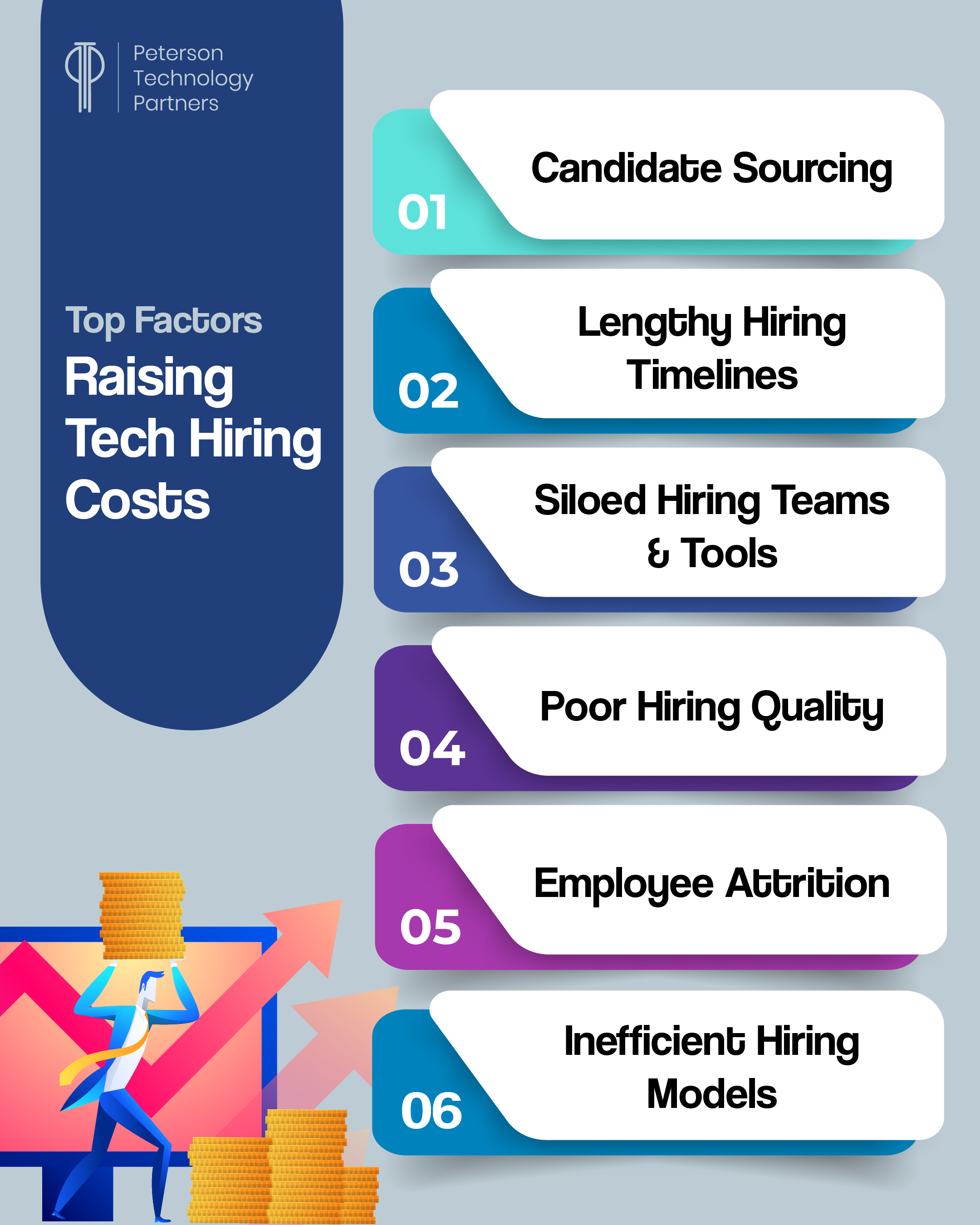Preview Summary
- Hidden tech hiring costs primarily come from candidate sourcing, lengthy hiring timelines, siloed teams and tools, poor hire quality, and employee attrition.
- Organizations lose an average of 25% of their SaaS budgets to unused entitlements and overlapping tools (Gartner).
- Replacing a single employee can cost between 50–400% of that person’s salary depending on their role and experience level (Applauz).
- Nearshore IT recruiting is a popular cost-saving method, with the savings benefits of offshoring but better collaboration leading to faster project timelines.
Introduction
Have you been noticing an increase in tech hiring costs for your business lately? You wouldn’t be alone. When you want the best tech talent, you want the best hiring strategy, and this can be quite an investment.
We’re not just talking about the cost of tech salaries. Investing in a successful hiring strategy also requires investments in:
- HR teams versed in tech talent hiring and management
- Hiring tech, like AI-powered ATS and communication channels
- A positive candidate and onboarding experience
In this article, we uncover more hidden costs of tech hiring and offer cost-effective tech staffing strategies to maximize your hiring ROI.

The Hidden Costs of Hiring IT Talent
Your organization’s journey toward IT staffing cost savings begins with understanding where costs are coming from. This list offers a glimpse of what components of the hiring process may be causing the biggest spending.
Tech Talent Sourcing Costs
The hiring process begins long before applications come flooding in, and so do the costs.
Advertising job listings, for example, can cost money. And while not every job board website requires payment—LinkedIn and Indeed only charge you when you “promote” or “sponsor” a listing—you need to account for the time it takes your hiring team to create, post, and monitor each listing.
Other costs may include premium candidate sourcing tools, which are increasingly powered by AI. In the long run, however, such tools may end up saving you money, thanks to their ability to enhance efficiency, quality of hire, and candidate experience.
Lengthy Hiring Timelines
Time is money when it comes to efficient recruiting.
When the hiring process is drawn out, candidates get bored and detached, making it easier for them to ghost, or worse, complain and deter other professionals from wanting to work for you.
This is another area where technology like AI can prove a worthy investment, with its ability to automate every step of the process—communication, scheduling, interviews and skill assessments, onboarding—so candidates don’t ever feel forgotten, and your team saves resources.
Siloed Hiring Teams and Tools
Inefficient HR strategies lead to big waste. According to research by Gartner, organizations lose an average of 25% of their SaaS budgets to unused entitlements and overlapping tools.
Does your organization pay for separate software to source candidates, schedule and execute interviews, analyze qualifications, and administer onboarding procedures?
A recruiting firm likely has its own streamlined process that integrates with your hiring team. By making one investment instead of several, you lower your risk of wasting money on redundant tools.
Poor Hiring Quality
Many employers think that all they need to improve tech hiring quality is deeper pockets for bigger salaries.
But there’s so much more that goes into hiring quality, like a comprehensive vetting process where cultural fit is prioritized as much as hard skills.
With AI tools taking on more repetitive tasks like technical screening, HR professionals have more time and energy to get to know a candidate’s soft skills and personality—making for longer-lasting hires while limiting turnover costs.
Cost of Employee Attrition
Replacing a single employee can cost between 50–400% of that person’s salary depending on their role and experience level, according to a recent study by Applauz.
Successful hiring teams prioritize a positive candidate experience, not just until papers are signed but well into the onboarding process. The alternative is poor talent retention, which means starting the expensive process all over again.
Employing tech talent retention strategies—from consistent communication with candidates to smooth onboarding for new hires to development opportunities for existing employees—is critical.
[Facing tech talent shortages? Learn tactics and tools for CIOs in this PTP Report.]
Reduce Tech Hiring Costs by Choosing the Right Hiring Model
Whether in-house or outsourced, on-site or remote, your choice in hiring model can make or break cost-effective tech staffing.
The IT outsourcing market is expected to grow at a CAGR of 8.5% from 2025 to 2035 (Business Research Insights). Why? Before, remote work was a need. Now it’s a tool for cost-effective staffing
And now that outsourcing has been around for a while, employers and recruiting firms alike have uncovered new and improved outsourcing solutions, like nearshoring.
Nearshore vs Offshore Outsourcing
When we say “offshore,” we’re referring to sourcing talent from regions far from the US, like Asia. Nearshore hiring, which sources candidates from closer regions like Mexico and South America, has the same cost-saving benefits as offshoring but with added benefits like:
- Overlapping time-zones
- Cultural alignment
- Fewer language barriers
- Fewer logistical/compliance barriers
These benefits can lead to more cost savings because smoother collaboration leads to faster project timelines—and we all know time is money.
[Dig deeper into nearshore, offshore, and “allshore” hiring in this PTP Report.]
Conclusion: PTP’s Nearshore IT Talent Solutions Offer the Best of Both Worlds
Expertise is closer than you realize. PTP’s nearshore services leverage tech recruitment best practices to match companies with nearby software developers, cybersecurity experts, project managers, and other in-demand professionals.
Don’t compromise quality to cut costs. PTP’s comprehensive recruitment process includes technical and cultural assessments, powered by AI and 27+ years of tech talent expertise.
FAQs
How can AI save money during the hiring process?
AI can optimize every step of the hiring process, from drafting job descriptions to onboarding hires. And as more business leaders get excited about agentic AI, they are investing in AI recruiters. While some of these agents only handle small portions of the process (i.e., scheduling and communication), more advanced models also administer initial phone screening and video interviews, and even score candidates based on pre-determined criteria. With agents able to handle the entire process, employers don’t need to invest in as many separate AI systems, preventing the cost of siloed teams, systems, and tools.
What tech roles are best to outsource with nearshore recruiting?
A wide variety of tech roles are suitable for nearshoring. Most software engineering roles, for example, can be filled by professionals from nearby remote locations, giving coding projects more eyes to improve the QA process—at a lower cost. Companies can also nearshore entire development teams, from developers to Scrum Masters to project managers. As AI becomes a huge priority for businesses, AI engineers, AI governance managers, and cybersecurity experts are also smart nearshoring options.
What are the benefits of partnering with a tech recruiting firm over relying on an in-house HR team?
More and more, recruiting firms are leveraging their own AI tools on top of their own talent pools. PTP, for example, has been leveraging its own AI agents to optimize the recruiting process, making us a one-stop solution for our clients’ entire hiring process, while still leveraging human expertise and collaboration. By partnering with a firm, companies allow their HR teams to focus on existing talent and their overall talent strategy—ultimately improving efficiency while performing more meaningful work that grows businesses.





